
Gamma-ray Burst 000630

On June 30, 2000 at 00:30:53 UT a burst was detected by
Ulysses, Konus-Wind, NEAR, and the BeppoSAX GRBM.
(All information courtesy of the instrument teams.)
 Previous IAU Circulars
Previous IAU Circulars
 Results of Observations
Results of Observations
- GCN notice #736
K. Hurley, on behalf of the Ulysses GRB team, T. Cline, on behalf
of the NEAR and KONUS Wind GRB teams, E. Mazets and S. Golenetskii,
on behalf of the Konus Wind GRB team, and F. Frontera, E. Montanari,
and C. Guidorzi, on behalf of the BeppoSAX GRBM team, report:
Ulysses, Konus-Wind, NEAR, and the BeppoSAX GRBM observed this
burst at 01853 s UT. As observed by Ulysses, it had a duration
~20 s, a 25-100 keV fluence ~2x10^-6 erg/cm^2, and a peak flux
over 0.25 s ~8x10^-7 erg/cm^2 s. We have triangulated it to
a preliminary 45 sq. arcmin. error box whose 3 sigma coordinates are:
RA(2000) DEC(2000)
14 h 47 m 14.72 s 41 o 13 ' 14.81 " (CENTER)
14 h 47 m 26.87 s 41 o 5 ' 1.45 " (CORNER)
14 h 46 m 53.86 s 41 o 17 ' 31.63 " (CORNER)
14 h 47 m 35.54 s 41 o 8 ' 58.02 " (CORNER)
14 h 47 m 2.53 s 41 o 21 ' 28.85 " (CORNER)
This error box may be improved.
- DSS2 image
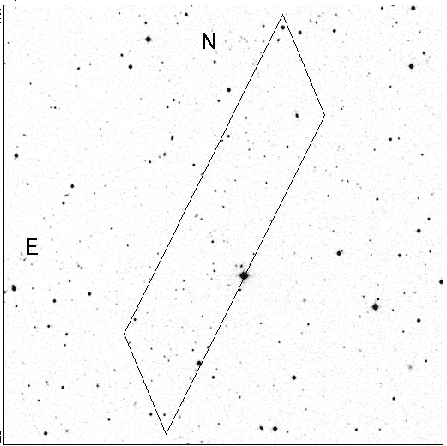
- GCN notice #737
C. Bartolini, A. Guarnieri, A. Piccioni (Bologna University) S. Bernabei
(Bologna Observatory) S. Covino (Brera Observatory) and G. L. Israel (Roma
Observatory) report:
A preliminary analysis of one 20 min. R image of the field of GRB 000630
(GCN 736) obtained on june 30.89 UT with a seeing of 1".8 reveals a possible
candidate at RA = 14 47 25.3, DE = +41 12 28 (error 2") not present in the
DSS2. A comparison with respect to the USNO 1275-08523886, 1275-08523650 and
1275-08523956 stars gives R= 20.5+-0.2 and a limiting magnitude R = 21.
Further observations are needed to confirm the proposed identification.
- GCN notice #738
E. Berger (Caltech) and D. A. Frail (NRAO) report on behalf of a larger
collaboration:
On July 1.04 UT we used the VLA at 4.86 GHz to observe the IPN error
region of GRB000630 (GCN 736). Inside the error region we find one bright
radio source, which is not present in either the NRAO VLA Sky Survey
(NVSS) or the Faint Images of the Radio Sky at Twenty-cm (FIRST) survey
(note that both these surveys are at 1.43 GHz). The position of the
source is RA=14 46 58.8, DEC=41 16 59.0 with a conservative error of 1".
A limit of 0.1 mJy can be placed on the absence of a radio source at the
position of the optical source reported by Bartolini et al. (GCN 737).
Further observations are planned.
- GCN notice #739
B. L. Jensen, H. Pedersen, J. Hjorth, J. P. U. Fynbo (U. of Copenhagen),
J. Gorosabel (DSRI, Copenhagen) on behalf of a larger European
collaboration, H. Schwarz (NOT) and D. G. Delgado (U. of Stockholm)
report:
We have obtained images covering about 95% of the error box reported
by Hurley et al. (GCN #736) with the 2.56-m Nordic Optical Telescope
(+ALFOSC) on La Palma on 2000 June 30.90 UT (about 21 h after the
burst). We obtained 3 x 300 sec R band exposures in seeing of 0.9".
Comparing with DSS-2 (red) exposure no convincing candidate down
to the limit of DSS (R~21.2) are found. We find no object at the
position of the proposed counterpart by Bartolini et al. (GCN #737),
but detect a star-like object (R = 21.0+-0.1) 3.5" to the south of
it at RA(J2000) = 14:47:25.37, Dec(J2000) = +41:12:24.1. This
object may be present on the DSS-2 (red) exposure. We find no
optical counterpart to the radio source of Berger et al.
(GCN #738) down to R = 24. The nearest optical source
(R = 24.5+-0.4) is located at RA(J2000) = 14:46.58.9,
Dec(J2000) = +41:17:00, ie. 1.5"+-0.5" from the radio source.
The photometry and astrometry reported here was based on the
USNO-A2.0 catalog. Images of the field are posted at:
http://www.astro.ku.dk/~brian_j/grb/grb000630/
- GCN notice #740
S. Zharikov, H. Plana, G. Tovmassian (Observatorio Astronomico Nacional
IA UNAM, Ensenada, Mexico), J. Greiner (AIP, Potsdam, Germany) report:
We have obtained two R-band (1200s and 600s) images of the GRB 000620
optical candidate (Bartolini et al., GNC737) field with the 1.5-m
telescope on July 1.17.
Photometric calibration was performed using PG1633+099BCD Landolt stars.
The R magnitude of object is 20.34+/-0.08. This object is visible on a
limit of DSS also.
We obtained two R-band (600s, 600s) images of the VLA radio source
(E. Berger (Caltech) and D. A. Frail (NRAO) et al. GNC 738) also. A
faint object at the radio position is presented on DSS but no detected
down to R~21.5.
- GCN notice #741
N. Masetti, E. Pian, E. Palazzi (ITESRE, CNR, Bologna),
J. Ticha, M. Tichy (Klet Observatory) and R. Hudec (ASU, Ondrejov),
on behalf of a larger collaboration, report:
Unfiltered optical images of the central part of the GRB000630
error box (GCN #736) were acquired on 2000 June 30.89 with the 0.57-meter
telescope (+CCD camera SBIG ST-8) of the Klet Observatory, Czech Republic,
for a total exposure time of 480 sec. The exposure was taken under bad
seeing (~3.5 arcsec) due to poor sky conditions.
No new or noticeable object down to a magnitude ~20.5 is detected inside
the imaged part of the IPN error box when we compare our summed frame
with the DSS-II Digital Sky Survey.
Also, no object is present at the position indicated by Bartolini et al.
(GCN #737).
The position of the radio source reported by Berger & Frail (GCN #738)
is instead not covered by our pointing.
- GCN notice #742
A. Henden (USRA/USNO) reports on behalf of the USNO GRB team:
We have acquired preliminary BVRcIc all-sky photometry for
an 11x11 arcmin field that covers the northern 60 percent of the
error box for GRB000630 with the USNOFS 1.0-m telescope on one
marginally photometric night. Stars brighter than
V=14 are saturated and should be used with care.
We have placed the photometric data on our anonymous ftp site:
ftp://ftp.nofs.navy.mil/pub/outgoing/aah/grb/grb000630.dat
The current photometry has a potential external zero-point
error of about three percent. The astrometry in this file
is based on linear plate solutions with respect to USNO-A2.0.
The internal errors are less than 100mas.
Further calibration of this field will be performed if
an optical afterglow is identified.
- GCN notice #743
J. Greiner (AIP, Potsdam),
A. Henden (USRA/USNO), on behalf of the USNO GRB team,
S. Merlino, J. Masegosa (IAA-CSIC Granada), Felipe Hoyo (CAHA, Almeria),
A.J. Castro-Tirado (LAEFF-INTA, Madrid, and IAA-CSIC, Granada),
S. Klose (Thueringer Landessternwarte, Tautenburg),
J. Gorosabel (DSRI, Copenhagen)
report on behalf of a larger collaboration:
R-band images of the GRB 000630 error box (Hurley et al., GCN #736) were
acquired according to the following table (note that the USNOFS
observations were made on two field centers, covering 100% of the error box):
Date (UT; Start) Telescope Exp.(s) Coverage Seeing Lim. Mag.
------------------------------------------------------------------------
0006 30.865 Calar Alto 2.2m 2*600 90% 1.4" 23.0
0007 1.181 USNOFS 1.0m 4*600 60% south 1.9" 22.5
0007 1.181 USNOFS 1.0m 4*600 60% north 1.9" 22.5
0007 1.292 USNOFS 1.0m 6*600 60% south 2.2" 22.5
0007 1.292 USNOFS 1.0m 4*600 60% north 2.2" 22.5
0007 1.894 Calar Alto 2.2m 2*900 100% 1.3" 24.0
------------------------------------------------------------------------
Photometric calibration was achieved with preliminary BVRcIc all-sky
photometry for the field of GRB000630 (Henden, GCN #742).
Comparison between these four epoch observations did not reveal any object
brighter than R ~ 22.5 mag showing variability larger than 0.3 mag.
We confirm the findings of Jensen et al. (GCN #739) on the Bartolini et al.
(GCN #737) object which appears constant in our images. We also do not
find any object at the radio source position reported by Berger et al.
(GCN #738) down to R = 23.5 mag.
- GCN notice #744
S. Yost, F. Harrison and A. Burgasser (Caltech) report on behalf of a
larger collaboration:
We imaged the entire error box of GRB000630 (Hurley, GCN 736) with the
CCD 13 instrument of the Palomar 60". Exposures consisted of R-band 4X900
seconds on the half of the error box containing the positions of Bertolini
et. al.'s optical candidate (GCN 737) and Berger & Frail's radio source
(GCN 738), and 2X900 seconds on the other half, on July 1.23 UT. The
seeing was approximately 0.9". Preliminary analysis reveals no objects at
either the optical or the radio candidate positions, to an approximate
limiting magnitude of R ~ 22.5. We will report a more precise limit
after further calibration of the field.
- GCN notice #745
J. P. Halpern (Columbia U.) & J. Thorstensen (Dartmouth)
report on behalf of the MDM Observatory GRB follow-up team:
We observed the location of the radio candidate for GRB 000630
(Berger & Frail GCN #738) in the I band on July 1.29 UT using
the MDM 2.4m telescope. A total exposure time of 25 minutes was
obtained in seeing of 1."5 and under non-photometric conditions.
We also obtained 15 minutes of exposure in the R band starting
on July 1.33 UT. Upper limits at the location of the radio
candidate of I > 23.3 and R > 23.2 were obtained, referenced to
these comparisons stars as calibrated by Henden (GCN #742):
Star RA(2000) Dec(2000) R I
-----------------------------------------------------
A 14 47 01.67 +41 16 16.9 17.42 16.84
B 14 46 59.25 +41 15 52.2 18.59 18.15
-----------------------------------------------------
Images of this field are posted at
http://www.astro.bio2.edu/grb/000630
- GCN notice #746
A. Henden (USRA/USNO) reports on behalf of the USNO GRB team:
We have acquired a second night of BVRcIc all-sky photometry for
an 11x11 arcmin field that covers the northern 60 percent of the
error box for GRB000630 with the USNOFS 1.0-m telescope.
We have placed the revised photometric data on our anonymous ftp site:
ftp://ftp.nofs.navy.mil/pub/outgoing/aah/grb/grb000630.dat
The current photometry has a potential external zero-point
error of less than two percent. The astrometry in this file
is based on linear plate solutions with respect to USNO-A2.0.
The internal errors are less than 100mas.
In particular, the position/magnitudes of the two stars
mentioned in Halpern, et al. (GCN 745) have the revised values of:
Star RA(2000) Dec(2000) R I
-----------------------------------------------------
A 14 47 01.67 +41 16 16.9 17.43 16.87
B 14 46 59.26 +41 15 52.2 18.60 18.14
-----------------------------------------------------
- GCN notice #747
B. L. Jensen, J. P. U. Fynbo, H. Pedersen, J. Hjorth (U. of Copenhagen),
J. Gorosabel (DSRI, Copenhagen), D. G. Delgado (Stockholm Observatory),
H. Schwarz (NOT) and A. Henden (USRA/USNO) report:
We present further R-band observations of the IPN errorbox of GRB 000630
(Hurley et al. GCN #736) obtained with the NOT 2.56-m and the USNOFS 1.0-m.
Comparison of three new epochs with our June 30.9 NOT observations (GCN #739)
reveals a single transient object (less than an arcmin from the center of the
IPN error box) which has faded monotonicly from 21 hours to 94 hours after the
burst. The position of the point-like object, which we identify as the likely
optical afterglow of GRB 000630, is RA(J2000) = 14:47:13.49, Dec(J2000) =
+41:13:53.3, with an astrometric uncertainty of 0.7" relative to the USNO-A2.0
catalog. Based on the photometric calibration of Henden (GCN #746) we find
the following magnitudes for the optical afterglow using PSF photometry:
Date 2000 UT Telescope Exp. time FWHM t_burst+ R (mag)
June 30.9 NOT 2.56-m 3x300 s 0.9" 21 h 23.04+-0.08
July 1.3 USNO 1.0-m 18x600 s 2.1" 29 h 23.13+-0.25
July 1.9 NOT 2.56-m 3x600 s 1.2" 46 h 24.05+-0.16
July 3.9 NOT 2.56-m 5x600 s 0.8" 94 h 24.70+-0.16
The lightcurve resulting from these data points is consistent with a power-law
decay with an index of -1.1 +- 0.3, assuming no contribution from an
underlying host galaxy. We note that the burst occurred in a region with an
apparent overdensity of galaxies. Sections of the images and a lightcurve are
posted at
http://www.astro.ku.dk/~brian_j/grb/grb000630/.
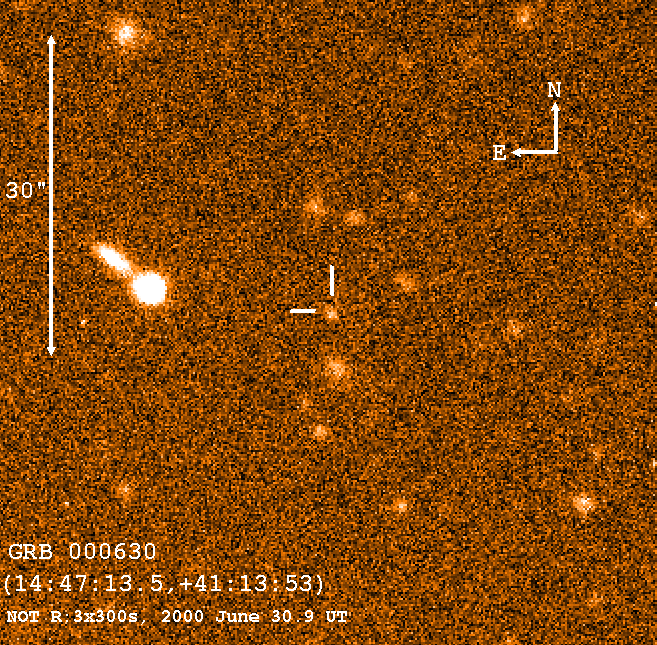
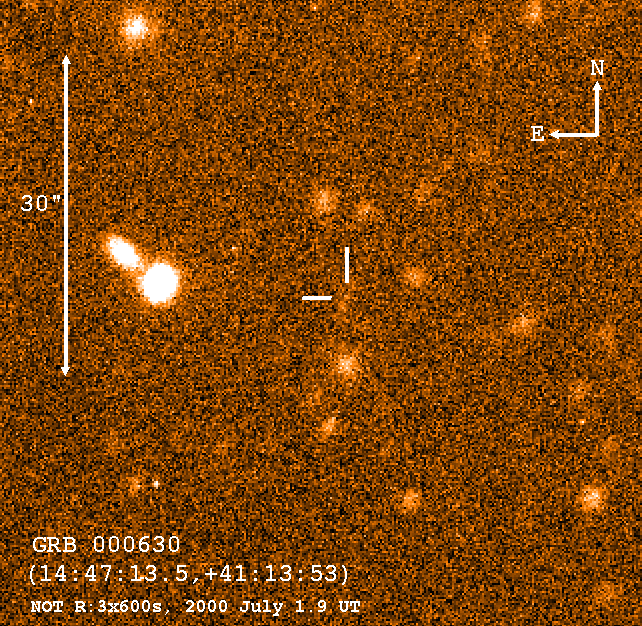
| NOT R:3x300s, 2000 June 30.9 UT (21 h after the burst) |
NOT R:3x600s, 2000 July 1.9 UT (46 h after the burst) |
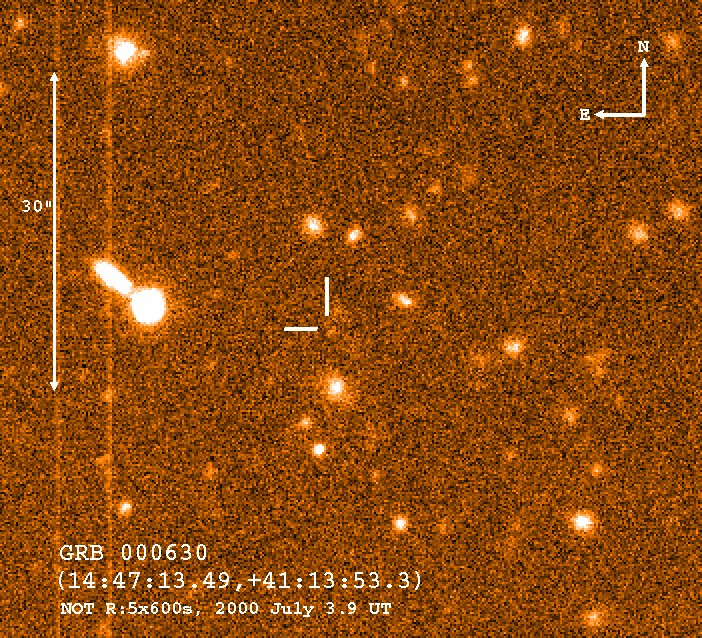
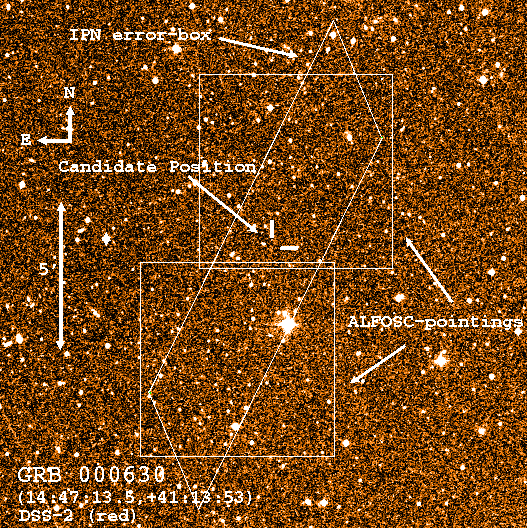
| NOT R:5x600s, 2000 July 3.9 UT (94 h after the burst) |
DSS-2 of the GRB 000630 field. The OT is located
near the center of the IPN error-box. |
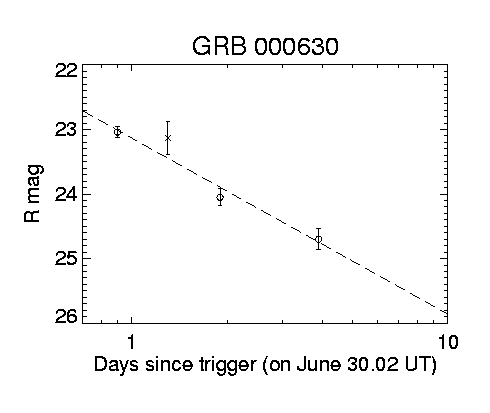 Lightcurve for the OT. Open circles are NOT photometry, The cross is USNO
photometry (see text for values). The slope is 1.1+-0.3 (assuming no
contribution from an underlying host).
Lightcurve for the OT. Open circles are NOT photometry, The cross is USNO
photometry (see text for values). The slope is 1.1+-0.3 (assuming no
contribution from an underlying host).
- GCN notice #748
S. Yost, F. Harrison and A. Diercks (Caltech) with J. Mulchaey (Carnegie
Observatories) report on behalf of a larger collaboration:
We imaged the error box of GRB000630 (Hurley, GCN 736) with the Cosmic
instrument of the Palomar 200". Exposures consisted of R-band 2X450
seconds on July 1.29 UT. The seeing was approximately 0.9". We detect an
object at the position of the optical afterglow reported by Jensen et al.
(GCN 747). We calibrated the field by PSF photometry, comparing 18 field
stars with the photometry of Henden et al. (GCN 746), and obtain a
magnitude of the optical afterglow as R = 23.47 +- 0.13.
- GCN notice #1069
D. L. Kaplan, J. A. Eisner, S. R. Kulkarni and J. S. Bloom,
California Institute of Technology, Pasadena, report
On June 19, 2001 UT, we observed the position of the optical transient
of GRB 000630 (Fynbo et al. astro-ph/0101425) with the Echelle
Spectrograph & Imager (ESI) on Keck II. Images were obtained in R and
I bands. The seeing was 0.75 arcsec but the observations suffered from
variable extinction due to clouds. In our preliminary analysis of the
R-band data we detect a faint source at the position of the OT. This
source is about 2 magnitudes fainter than the galaxy two arcseconds to
the North of the OT (see Fynbo et al. for discussion of this galaxy).
We identify this faint object as the host galaxy of GRB 000630.
Back to JG's
homepage
Jochen Greiner, last update: 19-Jun-2001
[Disclaimer]
![]() Previous IAU Circulars
Previous IAU Circulars 




